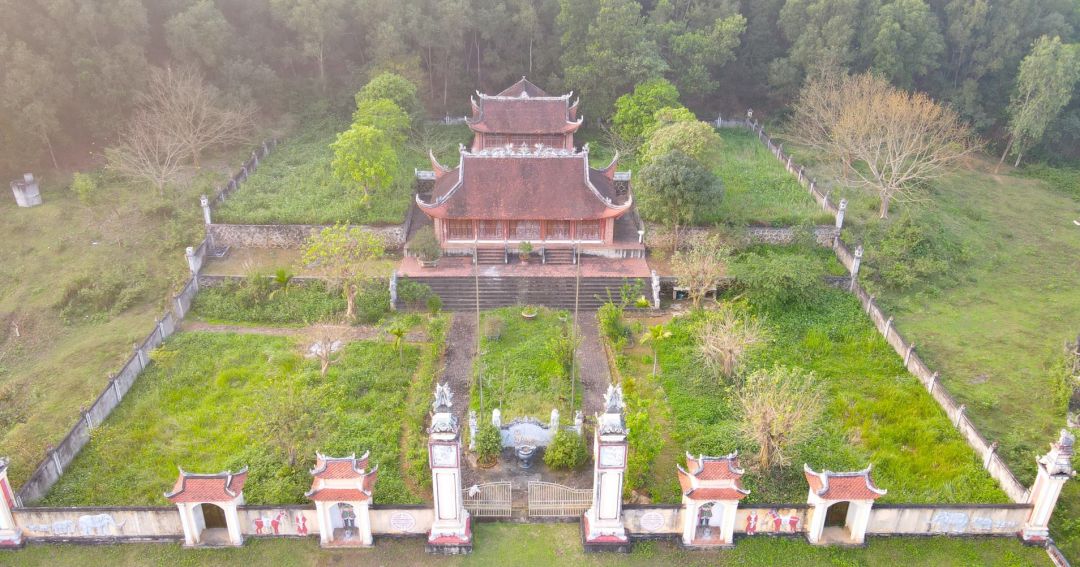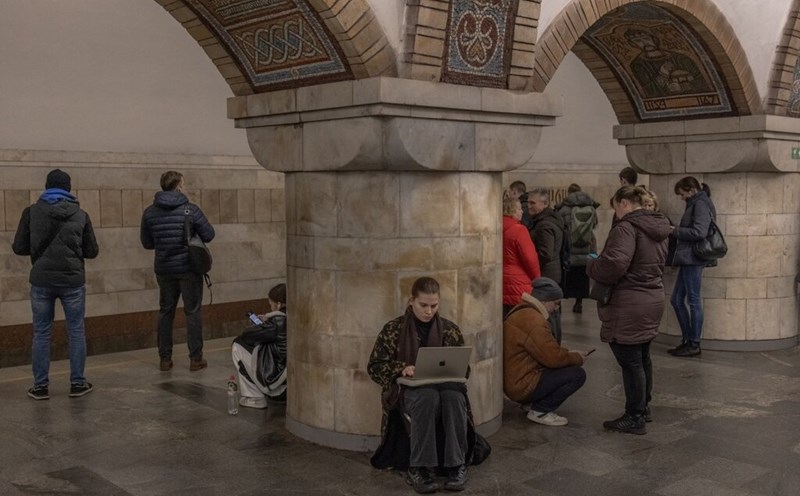Nghe An headquarters in Lam Thanh mountain for more than 300 years
Lam Thanh Mountain, today belongs to Hung Thanh Commune, Hung Nguyen District, Nghe An Province. Local people call it Ru Thanh. Historical records record that Lam Thanh Mountain is also called Dong Tru Mountain, Nghia Liet Mountain. Regarding Dong Tri Mountain, historical records record that during the Han Dynasty, after defeating Trung Nu Vuong, Ma Vien erected a bronze pillar here as the final boundary of Giao Chi land. For many generations, Lam Thanh Mountain has been highly regarded, a famous scenic spot in Nghe An. Dong Tru Mountain area was an important strategic location of the Ngo, Dinh, Tien Le, Ly, and Tran dynasties.
At the end of the Tran Dynasty, the maternal relative Ho Quy Ly usurped the throne and established the Ho Dynasty (1400 - 1407). According to the book "Nghe An Co Tich Luc": From 1397 onwards, Ho Quy Ly ordered people to build Rum citadel in Hung Nguyen and Trai citadel in Dien Chau. Quy Ly ascended the throne in 1400, Rum citadel became an important military base of the Ho Dynasty.
The Ho Dynasty's resistance against the Ming army failed. Ho Quy Ly and his son were captured and taken to Kim Lang. The Ming Dynasty established a protectorate government in our country, established districts and counties, built ramparts, and plundered wealth and brought it back to the North. During the Ming Dynasty, the enemy built Nghe An citadel and used it as the headquarters of Nghe An prefecture. The book "History of Nghe Tinh" recorded: "Nghe An citadel during the Ming Dynasty was both the headquarters of Nghe An prefecture and the most solid military base of the Ming invaders in Nghe An. During the process of suppressing the Tran Quy Khoang uprising, Truong Phu plundered the money, strength, and blood of the people of Nghe An to build this project" (LS NT p. 137).
According to historical records, on February 7, 1418, the leader Le Loi in Lam Son gathered patriotic heroes and raised an army to repel the invading Ming invaders. On October 12, 1424, he attacked Da Cang fort, from here he opened the way to Nghe An, liberated Tra Lan, Bo Ai, the enemy was defeated in Kha Luu, Do Gia. The Ming army led by Tran Tri and Son Tho fled to Nghe An citadel to defend: "After many consecutive defeats, the Ming army in Nghe An citadel retreated into a defensive, passive position. They firmly held the citadel gate" (Sdd.131). The Ming army was tightly surrounded. Thai Phuc, who was guarding the palace, opened the citadel gate and surrendered.
From 1428, Le Thai To established the Later Le Dynasty until 1655, nearly 300 years. Nghe An Citadel played the role of establishing a garrison in Nghia Liet. In August 1655, Trinh Truong moved to Vinh Doanh, Yen Truong commune to station troops. At that time, the Trinh - Nguyen war broke out, and was ambushed by the Nguyen army. The Trinh army lost the battle and fled to Yen Truong commune, Chan Phuc district to set up camp. Historical records clearly state that Trinh Toan was assigned to guard Nghe An, and brought his generals to set up camp in Yen Truong: "In June 1656, he ordered the Left National Palace Deputy General Phu Quan Cong Trinh Can to lead the generals to Nghe An to coordinate with Ninh Quan Cong Trinh Toan to fight the enemy. On the 18th, they arrived at Yen Truong to set up camp" (Continued Chronicle, Vol. 19).
The Trinh - Nguyen conflict had an impact on this famous place. During the Thinh Duc - Vinh Tho era, under the reign of Le Than Tong, the garrison of Nghe An was later moved to Vinh Doanh (Vinh) - Yen Truong, Chan Phuc district.

Lam Thanh scenic spot recorded in history books
Lam Thanh Mountain is a scenic spot. The book “Nghe An Ky” by Bui Duong Lich wrote: “Below the mountain, Lam River flows around; and La River, Minh River flows into. Looking up the mountain, you can see: To the West are Hung Linh Mountain and Dai Hue Mountain; To the North are Dai Hai Mountain and La Nham Mountain; To the South are Thien Nhan Mountain and Hong Linh Mountain; To the East are Kim Nguyen Mountain and Dung Quyet Mountain, all facing this mountain. The river water is clear, the trees and grass are lush, the streets near and far are elegant as a painting. It is truly a scenic spot in Nghe An”. Opposite Lam Thanh Mountain is Phu Thach Street, a gathering place for the Khach people in Vinh Dai village (now Quang Vinh Commune, Duc Tho). The book “Nghe An Ky” wrote: “Where Minh River flows into the floating rock. On the east side of the rock, there is a ferry called Phu Thach ferry. On the ferry, there is a street where the Khach people live. Houses are close together, boats are bustling”. Since the Tran Dynasty, Phu Thach and Lam Thanh land has been a famous scenic spot in Nghe An.
According to the book “Nghe An Co Tich Luc” it is recorded: During the Ly - Tran dynasties, the kings went to the South to fight the enemy, often stationed troops here (ie Lam Thanh mountain). During the Tran dynasty, Yen Quoc pagoda was built under the mountain, a large Zen monastery, along with An Quoc pagoda in Phu Thach on the southern bank of Lam river. The book “Dai Nam Thong Nhat Chi” wrote about Yen Quoc pagoda: “Behind the pagoda is Tuong Dau mountain, in front of the pagoda is Tien Chau stream (there is a copy of Tien Don) flowing from the mountainside, the water is fragrant and sweet, people call it Yen Quoc stream”.
Lam Thanh Mountain gathers many historical and cultural relics such as Yen Quoc Temple worshiping King Nghia Vuong Nguyen Bieu. According to history books, in 1413, Thi Ngu Su Nguyen Bieu obeyed the order of King Trung Quang of the Later Tran Dynasty as an envoy to Lam Thanh, met with the Ming general Truong Phu to ask for peace but the matter was unsuccessful. At first, Phu released Nguyen Bieu, then Phu listened to Phan Lieu and arrested him again. He ordered his soldiers to tie Nguyen Bieu at Yen Quoc Bridge, and used the tide to drown him. Nguyen Bieu bit his finger and wrote on the bridge wall 7 words: "that nguyet, nhat nhat, Nguyen Bieu tu" (July 1st, Nguyen I died). Then he sternly scolded Truong Phu. For three days the tide did not rise. Bieu's curses echoed in his ears. Truong Phu got angry and beat Nguyen Bieu to death. Remembering the merits of the righteous Nguyen Bieu, the people built 2 temples on Lam Thanh Mountain. They were called Yen Quoc Temple and Nghia Vuong Temple. The name of the mountain and the name of the village were both called Nghia Liet. In Nghia Liet mountain, Lam Thanh also gathers King Le temple, Thanh Liet temple, Yen Quoc pagoda, Ong pagoda, Mu pagoda, Ham Ho pagoda.
The Nghe An citadel relic on the Lam River was built on a high mountain running from the northeast slope down to the south, then up to the west. The citadel wall was made of mountain stone, lime, and honey. The citadel surface was trapezoidal, with watchtowers and gun emplacements for combat warning. There were 3 gates, including the main gate and 2 side gates.
Lam Thanh Mountain relic was recognized by the State as a National Historical and Cultural Relic. The decision document was dated April 28, 1998. Since then, the relic has been preserved and its historical and cultural value has been promoted, educating patriotism in each person.
Need to promote the value of Lam Thanh relic
During the Trinh - Nguyen war, Lam Thanh was the outpost of the Le - Trinh lords' army. According to historical records, in August 1655, Trinh Truong was defeated by the Nguyen army at Nam Gioi seaport and his generals fled to Yen Truong land (present-day Vinh), Chan Phuc district set up camp and divided his troops to station in the North of Lam river from Nghia Liet mountain to Dan Nhai gate to block the enemy. In June 1656, Phu district duke Trinh Can commanded the Trinh army, contracted with Trinh Toan to station in Yen Truong commune. Later, generals Le Thoi Hien, Dang Tien Thu, Truong Nhung, Nguyen Minh Chau were sent by Lord Trinh to guard and defend Nghe An, all stationed in Vinh Doanh, Yen Truong commune. From 1655 onwards, the military camp and the Nghe An headquarters were moved to Vinh Doanh, Yen Truong commune: "In the summer, April (1743), there was an order for Vinh district duke Dang Dinh Tru to command the Trung Han navy to stay in Nghe An, stationed at Vinh Doanh" (Dang family genealogy, complete official record, page 341). Therefore, the role of Lam Thanh mountain became secondary, until 1803, the Gia Long dynasty ended.
When the Nghe An town office moved to Vinh Doanh, the prosperity of Phu Thach and Cho Trang streets also faded. At that time, the Khach merchants also gradually moved their commercial activities to Vinh Doanh. Over hundreds of years, there were many destructive incidents of "water and fire bandits", Lam Thanh mountain, a famous scenic spot of Nghe An, has now become shabby and desolate to the point of being terrifying. The once tall and imposing citadel walls are now low and covered with wild plants, the stone walls are mossy and shaky, about to collapse.
Preserving historical values, Lam Thanh mountain was recognized by the State and ranked as a National Historical and Cultural Relic in 1998. However, since then, the relic has not been cared for and restored by the competent authority. The architectural works of the ancient citadel such as: Flagpole, gun emplacement, elephant lake, horse lake... now only have a few vestiges left.
Lam Thanh (Nghe An ancient citadel) on Nghia Liet mountain by Lam river has not yet promoted the value and potential strengths of the heritage. It is necessary to pay attention to the conservation and restoration of items at Lam Thanh Mountain Historical and Cultural Relic to awaken the potential and strengths of this famous scenic spot in Nghe An.










